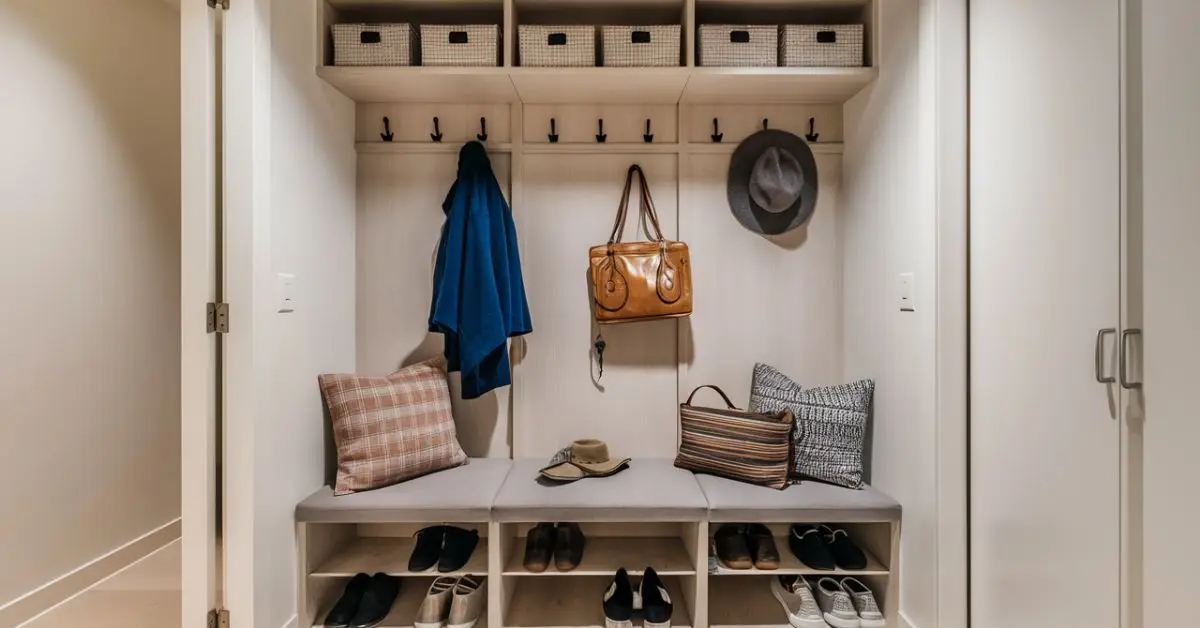Your Entryway Might Be Ruining Your Home s First Impression Here s How to Fix It
As a designer, I’ve visited dozens of homes, and if I’ve learned anything, it’s that the atmosphere created in the foyer shapes the rest of the house. Like a handshake, it can be friendly and cordial or awkward and unmemorable.
The majority of folks aren’t even aware that their entrance conveys the incorrect message. It might be cluttered. Perhaps the lighting is chilly. Or perhaps it simply feels strange. Whatever it is, the first five seconds a visitor enters your house can influence their opinion of the entire house before they even see anything else.
I’ll list the five most frequent entrance errors I frequently find in this post. More significantly, I’ll explain how to prevent them using easy, practical solutions that genuinely work. Nothing pretentious or Pinterest-perfect. Simple, useful design principles that everyone may apply.
Before we get started, I have a quick question: When you enter someone’s house, what do you notice right away?That’s exactly how people feel when they go into yours, so think about it.
1. Ignoring Lighting and Making the Whole Space Feel Off
You know how it feels to enter a location and not be able to pinpoint why it feels unfinished or cold? It is almost always the lighting.
The majority of entryways are either too harsh, with antiseptic white light that makes the area feel like a waiting room, or too dim, with only one depressing bulb. Neither exudes a friendly greeting. And if there isn’t any natural light entering your home? More justification to reconsider your arrangement.
Not only can a well-lit entryway improve the appearance of the room, but it also improves your mood as you enter your house.
This is what works:
- Add a statement light fixture if you ve got ceiling height it becomes instant decor.
- Use warm white bulbs (around 2700K) instead of cool ones. Huge difference in mood.
- If your entry is dark, layer in wall sconces or a table lamp on a console soft light adds charm.
- Got natural light? Great don t block it with bulky furniture or dark curtains.
Expert advice: Despite being the first and final room that people enter and exit, lighting is one of the most neglected aspects of an entryway, according to Martha Stewart’s design editors.
Lighting has an impact on your space’s appearance, cleanliness, and even your attitude when you walk in after a hard day. Your home is forgettable if it has poor lighting. It is memorable when it is well-lit.
2. No Clear Drop Zone and the Clutter Starts Piling Up
Before you know it, your entryway is a complete disaster after you arrive home, throw your keys in a random location, kick off your shoes, and drop your luggage on the closest surface. Does that sound familiar?
You are not the issue. The reason is that no system is in place. The majority of entryways lack a suitable drop zone, which is a place set aside for daily necessities. And clutter takes over when there isn’t one.
Here’s how to make that right:
-
Use a
shallow console table
with a bowl or tray for keys, mail, and sunglasses. -
Install a
wall-mounted shelf
or floating cubbies if you re tight on space. -
Place a small
bench with hidden storage
underneath for shoes and bags. -
Add
hooks
(not just one) for coats, totes, dog leashes whatever you actually use daily.
A mudroom is not necessary. All you need is organization.
There is a lot of traffic at the entrance. Clutter usually prevails when there is no plan. A clear drop zone makes the area feel peaceful rather than disorganized and helps you keep organized without having to think about it. These room-by-room decluttering tips can help you reorganize your home’s flow from the doorway inward if your area tends to accumulate clutter at the end of the day.
3. Oversized or Undersized Rugs Making the Space Look Unfinished
Let’s discuss rugs. Many individuals utilize ones that are much too small or completely ignore them. Both can subtly detract from the appearance of your foyer.
Everything feels unbalanced, as if you neglected to finish the room, when the rug is too small. However, a too large rug might overpower the entry, particularly if it coils up against door frames or furniture.
This is what genuinely works:
-
Choose a rug that fits the
width of the doorway
and extends far enough in so you can take at least one or two steps onto it. -
For narrow entries, go with a
runner
it draws the eye in and adds warmth without crowding the space. -
Use
low-pile or indoor-outdoor rugs
they re easier to clean and don t trap dirt. -
Don t forget a
non-slip rug pad
safety matters more than aesthetics here.
One of the most common entryway errors, according to Homes & Gardens, is choosing the incorrect carpeting material, which not only looks sloppy over time but also deteriorates more quickly in high-traffic areas.
The room is grounded by your rug. If it’s the proper size and substance, it provides warmth, texture, and functionality. If you do it incorrectly, your entryway may appear awkward or empty.
4. Generic Decor and No Sense of Personality
Let’s face it, many entrances have the atmosphere of a hotel lobby. Technically sound, but completely unmemorable.
A generic mirror, a phony plant, or perhaps a neutral poster that might be seen in any home are examples of too-safe décor. The issue? It says absolutely nothing about you. Additionally, that lack of individuality makes the entire house seem less welcoming to visitors.
Here’s a way to address that without going too far:
-
Hang
one personal piece
a framed photo, travel art, or something with a story behind it. -
Add a
vintage mirror
, hand-me-down console, or something that feels collected not store-bought. -
Use objects that
hint at your lifestyle
like a bowl of beach shells, a small book stack, or even your favorite candle. -
Layer in texture with
woven baskets, ceramics, or textiles
it softens the space. Want more decor that s personal, not pricey? Try thesestylish, budget-friendly home office upgrades
many ideas work beautifully in entryways too.
According to design experts quoted in LivingEtc, a typical mistake is to make entryways so well managed that they lose all of their warmth.
The front door is the first impression of your house. You shouldn’t feel as though you’re on a catalog site. People immediately connect when they step in and see something genuine.
5. Blocking Flow Making It Hard to Move Through the Space
The entryway simply doesn’t work sometimes. As soon as you enter, you run into a bench. Alternatively, a large cabinet just behind the door makes it difficult to open. You might be surprised to learn how frequent that layout problem is.
Many individuals attempt to cram too much décor or furniture into a space without considering how it will be used. However, a doorway is a space for movement as well as sight. The entire house feels strange as soon as you walk in if the flow is confined, unnatural, or unclear.
What to do instead is as follows:
-
Leave
at least 36 inches of clearance
around the door that s the minimum comfortable flow space. -
Use
narrow furniture
if your entry is tight (look for pieces labeled under 12 inches deep). -
In very small spaces, consider
wall-mounted options
like floating shelves or slim shoe cabinets. -
Watch for
door swing paths
both front door and nearby closet doors. Test how far they open.
According to experts at Saint-Gobain Glass, a common design error in Indian homes, whose entryways are frequently small and multipurpose, is to disregard movement and spatial coherence.
Entering your home shouldn’t require you to go through an obstacle course. A seamless, unhindered entryway gives your room a purposeful, livable vibe.
Bonus Tip: What to Never Do in Small Entryways
Avoiding design errors is even more crucial if your doorway is small because every inch matters.
Here are some things not to do:
- Don t squeeze in bulky storage furniture just to have something there
- Avoid open shoe racks they look messy fast and visually crowd the space
- Skip oversized artwork or mirrors that don t reflect natural light
What is more effective:
- Use a leg-free, wall-mounted console it visually opens the floor and still gives surface space
- Install floating shelves or corner hooks to save precious square footage
- Choose a narrow, minimalist coat rack instead of a full closet setup
Scale and proportion are frequently cited by design experts as the main causes of narrow entryways feeling claustrophobic. Open shoe racks tend to create more clutter than they solve, especially in Indian homes with monsoon mud and dust.
Layout Fix:Try a one-wall layout keep all your drop zone elements (hooks, mirror, shelf) along one clean wall. Don’t put anything behind the door or clog corners.
In small entries, wrong choices feel louder. This section helps readers avoid common traps and still get function without sacrificing flow.
Quick Visual Checklist
Use this no-nonsense checklist to assess your entryway in seconds. Print it, screenshot it, or just walk through your door with it in mind.
- Flow plan is clear (no furniture blocking path)
- Storage is minimal but useful (no piles, hidden if possible)
- Lighting feels warm, not harsh
- Rug is right-sized and clean
- D cor is intentional, not generic
- No bulky or oversized furniture
This checklist gives the reader a quick win. It turns ideas into immediate action boosting clarity and confidence without overthinking.
Make It Last Care and Maintenance Tips
Creating a clean, organized entryway is one thing. Keeping it that way is another.
Here s how to build simple habits into your routine:
- Set a no-shoes rule or place a quality doormat outside and inside
- Clean under your rug and pad every month it traps more dirt than you think
- Dust mirrors, lamps, and consoles weekly
- Replace burnt-out bulbs right away
- Rotate small d cor items seasonally it keeps things fresh with zero cost
Experts recommend treating your entry like a semi-public zone. If it wouldn t pass in a guest house, it needs a reset.
Without maintenance, even the best entry design fades. This section helps the reader make their changes sustainable and future-proof. Struggling with daily mess in your entryway? Start here10 things you can throw out todayto instantly clear space and calm the chaos.
Final Thought: Your Entryway as a Promise, Not an Afterthought
Your entryway isn t just a spot to walk through it sets the tone for your entire home.
When it s neglected, it signals disconnection and disorganization. But when it s intentional, even in small ways, it feels like a welcome. A pause. A moment of care.
That s not about money or square footage it s about clarity. When you walk in and everything has a place, even a tiny entry can feel calm and powerful.
So ask yourself:Does your entryway reflect what you want from your home? Or is it stuck in survival mode?
Start with one change. That s all it takes to shift how your home feels for you, your family, and anyone walking in.
Want more practical home improvement tips like this?VisitBuild Like Newfor guides, fixes, and smart ideas that actually work.
Disclaimer:This article is for informational purposes only. Always consult a qualified interior designer or home professional for personalized advice based on your space and needs.
Table of Contents
-
1. Ignoring Lighting and Making the Whole Space Feel Off
-
2. No Clear Drop Zone and the Clutter Starts Piling Up
-
3. Oversized or Undersized Rugs Making the Space Look Unfinished
-
4. Generic Decor and No Sense of Personality
-
5. Blocking Flow Making It Hard to Move Through the Space
-
Bonus Tip: What to Never Do in Small Entryways
-
Quick Visual Checklist
-
Make It Last Care and Maintenance Tips
-
Final Thought: Your Entryway as a Promise, Not an Afterthought




